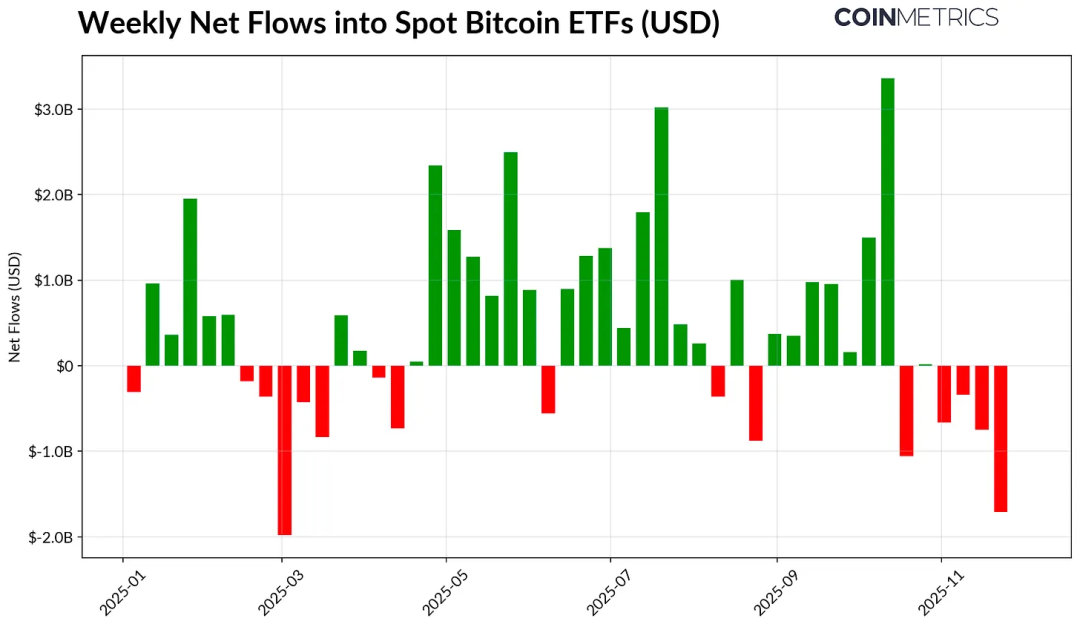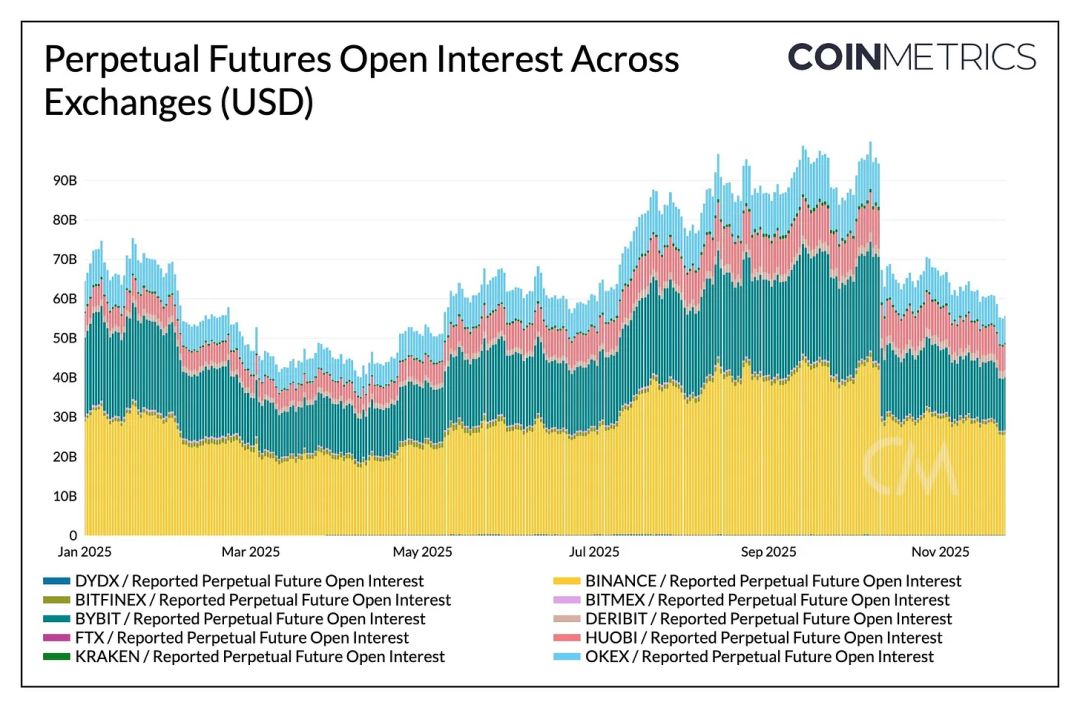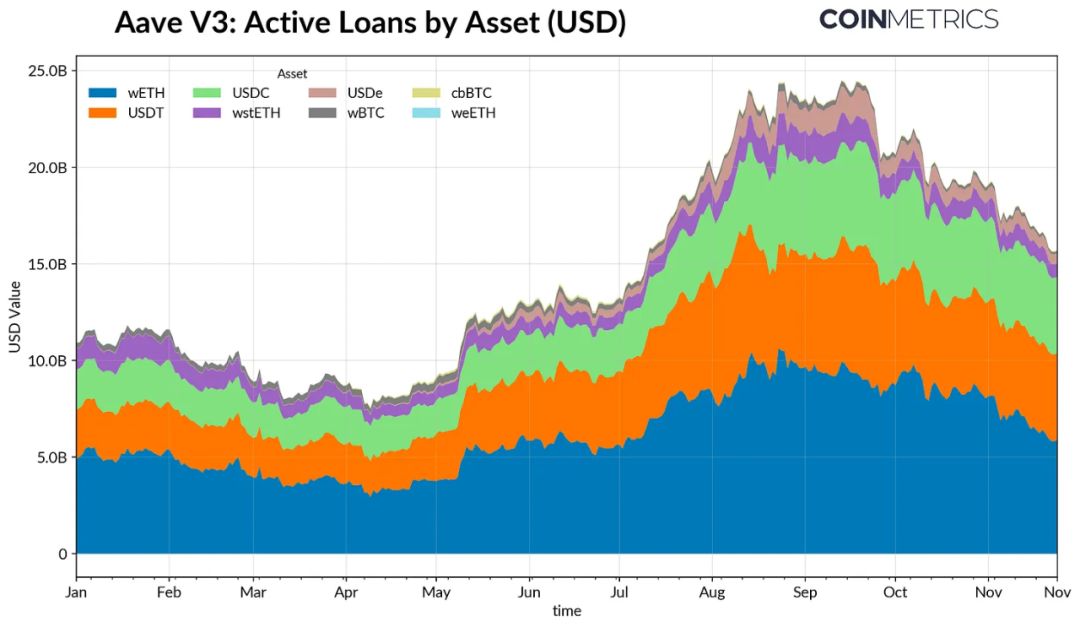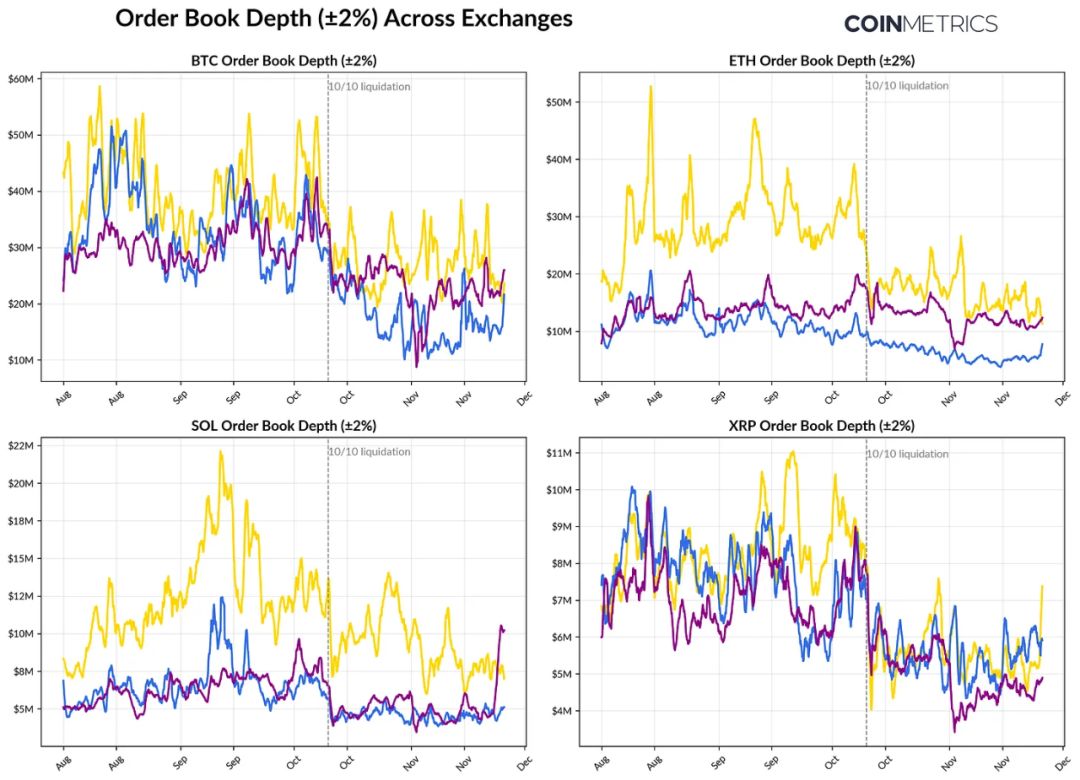The Crypto Market Amid Liquidity Drought: The Dual Test of ETFs and Leverage
Author: Tanay Ved, Coin Metrics
Translation: GaryMa Wu Shuo Blockchain
Original Title: ETF Outflows, Leverage Washout, and Liquidity Drought: Where Is the Way Out for the Crypto Market?
Key Points Summary
· Demand from major absorption channels such as ETF and DAT has recently weakened, while the deleveraging event in October and the macro backdrop of declining risk appetite continue to put pressure on the crypto asset market.
· Leverage in futures and DeFi lending markets has been reset, with positions becoming lighter and cleaner, thereby reducing systemic risk.
· Spot liquidity has not yet recovered; both mainstream assets and altcoins remain weak, making the market more fragile and more susceptible to unexpected price swings.
Introduction
“Uptober” started off strong, driven by bitcoin hitting new all-time highs. But optimism was quickly interrupted by October’s flash crash. Since then, BTC has dropped by about $40,000 (over 33%), with altcoins taking an even bigger hit, bringing the total market cap close to $3 trillion. Despite positive fundamental developments this year, price performance and market sentiment have clearly diverged.
Digital assets appear to be at the intersection of multiple external and internal forces. On the macro level, uncertainty over a December rate cut and the recent weakness in tech stocks have exacerbated the decline in risk appetite. Within the crypto market, core absorption channels such as ETF and Digital Asset Treasury (DAT) have seen outflows and increased cost pressures. Meanwhile, a round of market-wide liquidations on October 10 triggered the most intense deleveraging event in recent years, with aftershocks still ongoing as market liquidity remains shallow.
This report will break down the driving forces behind the recent weakness in the crypto asset market. We will delve into ETF fund flows, perpetual futures and DeFi leverage conditions, as well as order book liquidity, to explore how these changes reflect the current state of the market.
Macro Environment Shifts Toward Lower Risk Appetite
The performance gap between bitcoin and major asset classes is widening. Gold has risen more than 50% year-to-date, driven by record central bank demand and ongoing trade tensions. Meanwhile, tech stocks (NASDAQ) lost momentum in Q4 as the market reassessed the probability of Fed rate cuts and the sustainability of AI-driven valuations.
As our previous research has shown, the relationship between BTC and “risk assets” like tech stocks and “safe haven assets” like gold swings cyclically with the macro environment. This means it is especially sensitive to sudden events or market shocks, such as October’s flash crash and the recent decline in risk appetite.

As the anchor of the entire crypto market, bitcoin’s pullback continues to transmit to other assets. Although privacy-themed tokens occasionally show brief outperformance, the overall trend remains in sync with BTC.
ETF and DAT: Weakened Absorption Demand
Part of the reason for bitcoin’s recent weakness is that the absorption channels that supported it for most of 2024–2025 have started to falter. Since mid-October, ETFs have seen several consecutive weeks of net outflows, totaling $4.9 billion. This is the largest round of redemptions since April 2025, when bitcoin fell to around $75,000 due to tariff expectations. Although short-term outflows are significant, on-chain holdings remain on an upward trend, with BlackRock’s IBIT ETF alone holding 780,000 BTC, accounting for about 60% of total spot bitcoin ETF supply.
If funds return to sustained net inflows, it would signal stabilization of this channel. Historically, when risk appetite improves, ETF demand has always been a key absorber of supply.

Digital Asset Treasuries (DAT) are also under pressure. As the market declines, the market value of their stocks and crypto holdings is compressed, putting pressure on the NAV premium that supports their fission growth mechanism. This limits their ability to raise new capital by issuing more shares or debt, thereby restricting their capacity to increase the “crypto asset per share” allocation. Smaller or newer DATs are especially sensitive to these changes and become more cautious when cost bases and equity pricing turn unfavorable.
Strategy — currently the largest DAT — holds 649,870 BTC (about 3.2% of total supply), with an average cost of $74,333. As shown below, Strategy’s accumulation accelerated sharply when BTC rose and its stock price performed strongly, but has slowed significantly recently, though it has not become an active selling force. Even so, Strategy remains in a floating profit position, with costs below the current price.
If BTC falls further, or if it faces the risk of index removal, Strategy may come under pressure; but if the market reverses and its balance sheet and valuation improve, it is likely to resume a stronger accumulation pace.

On-chain profit indicators also reflect this situation. The Short-Term Holder SOPR (<155 days) has fallen into a ~23% loss range, which usually means the most sensitive holder group is engaging in “capitulation” selling. Long-term holders are still, on average, in profit, but SOPR also shows a mild selling tendency. If STH SOPR returns above 1.0 while LTH selling pressure eases, it would indicate the market may regain its footing.
Crypto Market Deleveraging: Perpetual Futures, DeFi Lending, and Liquidity
The liquidation wave on October 10 kicked off a multi-layered deleveraging cycle across futures, DeFi, and stablecoin leverage, whose effects have not yet fully dissipated.
Perpetual Futures Leverage Washout
Within just a few hours, perpetual futures saw the largest forced deleveraging in history, wiping out more than 30% of open interest accumulated over months. Platforms with a higher proportion of altcoins and retail users (such as Hyperliquid, Binance, Bybit) suffered the deepest declines, consistent with the aggressive leverage previously built up in these areas. As shown below, current open interest remains significantly below the pre-flash crash peak of over $90 billion, and has since edged down further. This indicates that leverage in the system has been substantially washed out, and the market has entered a phase of stabilization and repricing.
Funding rates have also dropped in tandem, reflecting a reset in long-side risk appetite. BTC funding rates have recently hovered around neutral or slightly negative, consistent with a market that has not yet regained clear directional confidence.

DeFi Deleveraging
The DeFi credit market has also undergone a gradual deleveraging process. Active loans on Aave V3 have been steadily declining since the late September peak, as borrowers reduce leverage and repay debts. The contraction in stablecoin lending is most pronounced, with USDe depegging triggering a 65% drop in USDe lending volume and further igniting a liquidation chain in synthetic dollar leverage.
ETH-based lending has also contracted, with WETH and LST-related loans down 35–40%, indicating a significant exit from looped leverage and yield strategies.

Shallow Spot Liquidity
Spot market liquidity has not recovered since the October 10 liquidation. The order book depth (±2%) on major exchanges is still 30–40% lower than in early October, indicating that liquidity has not been restored as prices have stabilized. With fewer orders on the book, the market is more fragile, and even small trades can cause excessive price impact, amplifying volatility and the effects of forced liquidations.
Liquidity conditions for altcoins are even worse. Order book depth outside of mainstream assets has declined more and for a longer period, showing that the market continues to avoid risk and market maker activity has dropped. If spot liquidity improves across the board, it could reduce price impact and promote stability, but for now, depth remains the clearest indicator that systemic stress has not dissipated.

Conclusion
The digital asset market is undergoing a comprehensive recalibration, characterized by weak ETF and DAT demand, a reset of futures and DeFi leverage, and still-shallow spot liquidity. These factors have suppressed prices but have also made the system healthier: lower leverage, more neutral positions, and greater importance of fundamentals.
Meanwhile, the macro environment remains a headwind: weak AI tech stocks, volatile rate cut expectations, and declining risk appetite continue to dampen market sentiment. Only when major demand channels (ETF fund flows, DAT accumulation, stablecoin supply growth) recover, combined with a rebound in spot liquidity, can the market hope to stabilize and reverse. Until then, the market will continue to be pulled between a “macro environment of declining risk appetite” and “structural changes within the crypto market.”
Disclaimer: The content of this article solely reflects the author's opinion and does not represent the platform in any capacity. This article is not intended to serve as a reference for making investment decisions.
You may also like
Ethereum Privacy’s HTTPS Moment: From Defensive Tool to Default Infrastructure
A summary of the "Holistic Reconstruction of Privacy Paradigms" based on dozens of speeches and discussions from the "Ethereum Privacy Stack" event at Devconnect ARG 2025.

Donating 256 ETH, Vitalik Bets on Private Communication: Why Session and SimpleX?
What differentiates these privacy-focused chat tools, and what technological direction is Vitalik betting on this time?

Ethereum Raises Its Gas Limit to 60M for the First Time in 4 Years

DeFi: Chainlink paves the way for full adoption by 2030

